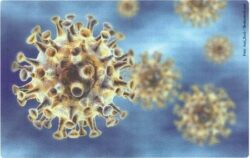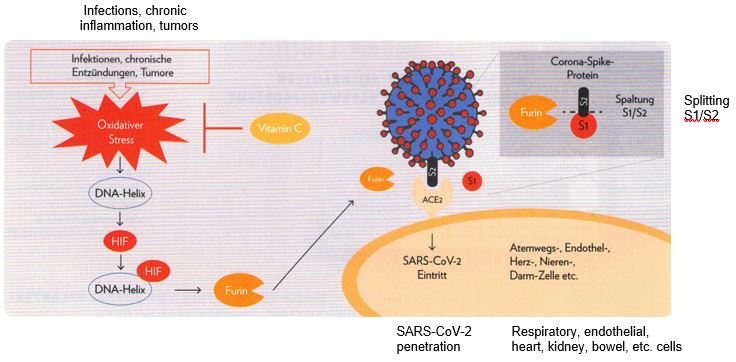For Readers in a Hurry
Besides psychosocial factors, the effectiveness of our infection defense depends particularly on an optimal supply of micronutrients. In times of increased infection risk supplementation with Vitamins C and D, zinc, selenium and Omega-3 fatty acids can strengthen our resistance to infections.

The so called coherence feeling – a sense of consistency – and a good supply of micronutrients reduce the risks of a viral infection. This also applies for SARS-CoV-2 infections and for the COVID-19 course.
In the last half year we were very frequently reminded of the elementary prevention measures like adherence to a large enough distance of at least 1.5 meters and thorough hand washing. Too briefly however, recommendations came for good care with vitamins and trace elements and for psychosocial factors.
The Coherence Feeling Protects Against Illness
The concept of the coherence feeling was already described in the beginning of the 1980s by Aaron Antonovsky *, when he started to examine which factors are needed for the origin and preservation of health. It is a feeling of coherence (consistency) and is based on three components. First it is important that challenges are perceived understandably and plausibly (comprehensibility). Then we need the conviction that we can manage and/or control the challenges, or we can leave that on other people or a higher authority who is capable (handleability/manageability). And thirdly – and this is possibly the most important – we must feel the meaningfulness/importance of our own lives and activities. Then we regard it as worthwhile and meaningful to deal with the upcoming challenges.
To visualize this can be important in crisis periods – like the proclaimed Corona pandemic from the SARS-CoV-2 virus. Many patients and also we ourselves maybe miss the understandability in the media reporting; many questions are open, experts are contradictory, figures are misleading and society seems split. Also the components of handleability and manageability are strained during the Lockdowns, or rather in isolation, when it comes to multitasking between work and child care. Additionally, fear of the virus that is often strengthened through frequent media reporting can affect our coherence feeling.
Why Do Many Not Fall Ill After a Virus Exposure?
As further described below, a good supply of micronutrients like Vitamin C can hinder the penetration of SARS-CoV-2. But psychological factors also play an important role. Nevertheless, the stress we are exposed to through the Lockdown and the fear-generating reporting is also fundamental.
Stress leads to a decreased resistance towards respiratory viruses.
For 35 years Psychology Professor Sheldon Cohen and his University laboratory dealt with the identification of psychosocial factors with illness emergence. To follow up on this question of who falls ill after a virus exposure, they examined the behavior-related, social and psychological factors with a study group of healthy adults. The test people were exposed to a cold or flu virus and then were observed during five or six days in quarantine whether a respiratory illness occurred. According to his research results, after virus exposure the factors associated with a higher risk for respiratory illnesses included smoking, too low Vitamin C intake and chronic psychological stress. The factors which were associated with a lower risk included social integration, social support, physical activity, adequate and efficient sleep as well as moderate alcohol consumption. The authors desire that their results be included in the crisis management of the Corona pandemic, because the reported factors of influence are replicable over several respiratory viruses and could also therefore absolutely play a similar role with COVID-19(1). It is generally recognized that accommodation at home and the loss of their job with the quarantine of the patients can release psychological suffering, fear and depression. However strong support networks can weaken these effects. As a result, Cohen’s studies show that the experiences in the context of the lockdown, i.e. interpersonal stressors through conflict, but also isolation and loneliness during quarantine and the loss of their job are particularly strong predictors for a weakened resistance toward respiratory viruses.
A large scale Swiss study in which 10,000 people were questioned shows that the Lockdown has led to a tremendous psychological stress in the population. Even though fear decreased after the easing [of restrictions] at the end of May, depression partially continued existing(2).
The Lockdown has led to a tremendous psychological stress in the population.
COVID-19 Is a Systemic Illness
At first the lung damage from COVID-19 stood in the foreground. However, relatively quickly the systemic vascular inflammation with its consequences became obvious. Meanwhile it is clear that the direct viral damage concerns many tissues because ACE-2 – the entry port for the Corona virus SARS-CoV-2 – is found on respiratory, endothelial, kidney and bowel cells. Admittedly, scientists still presume another receptor than the entry port in the lung tissue. Also obvious in past months is that not only direct viral tissue damage plays a role in the symptoms and the COVID-19 course. The systemic damage of the vascular interior wall and the thrombo-inflammation lead to circulatory disturbances and even to embolisms, and the tissue damage of the cytokine storm injures organs like the lung and affects our immune system. Lymphopenia is a characteristic problem with COVID-19.
US-American cardiologists recently published which clinical symptoms beyond the lung occur with COVID-19 patients – almost all organs are affected. Neurological, gastroenterological and dermatological manifestations, cardiac, endocrinological, renal and hepatic symptoms occur(3).
Therefore an immune modulation is fundamentally important, and for this our immune system needs vitamins and supplements which support the antiviral infection defense and at the same time prevent an overshooting inflammation. Vitamin C is an essential immune modulator which is necessary for many antiviral and antibacterial immune reactions(4) and at the same time protects from the cytokine storm that otherwise damages the lung and blood vessels(5) (see Table 1 and Figure 1). The result is a high Vitamin C expenditure, which very often leads to a distinctive deficiency – especially with pneumonia(5, 6).
 Table 1: Supportive effect of Vitamin C with COVID-19
Table 1: Supportive effect of Vitamin C with COVID-19
 Figure 1: Systemic oxidative stress and the cytokine storm caused by COVID-19 tissue, blood circulation and coagulation disturbances are responsible for many complications. Vitamin C has an antioxidative and anti-inflammatory effect.
Figure 1: Systemic oxidative stress and the cytokine storm caused by COVID-19 tissue, blood circulation and coagulation disturbances are responsible for many complications. Vitamin C has an antioxidative and anti-inflammatory effect.
Immune modulation is important in order to support the infection defense and to prevent overshooting inflammations.
Vitamin C Impedes the Penetration of SARS-CoV-2 through ACE2
Corona virus is a very good conformist to the cells that it infects. So that the virus can bind to the host cell and penetrate into it, the so-called spike protein of the virus must first be split by the protease belonging to the host. The virus is virtually only activated through a human enzyme. Current influenza and corona viruses are activated by a specific set of proteases, which typically appear in the respiratory epithelial cells. Early characterizations of the SARS-CoV-2 genomes showed that this exhibits a cleavage site [splitting] for the protease furin. However furin occurs not only in the respiratory tract, but also in a lot of tissue types. Exactly like the ACE receptor – the entry port for SARS-CoV-2. Therefore the virus can infiltrate many tissues and exactly this systemic pathogenicity is observed with COVID-19. Although the furin inhibition would be a promising goal for the treatment of COVID-19, a systemic inhibition would inevitably lead to disadvantageous consequences, because furin is involved in a variety of important physiological activities. However Vitamin C can have a modulating effect on furin formation, since the formation of furin is over the Hypoxia-inducible factor (HIF). Oxidative stress appears with all chronic inflammation illnesses and of course with infections, activates the formation of HIF through the transcription factor NRF2. On the other hand HIF is even a transcription factor – thus a gene trigger – which induces formation of furin (see Figure 2). This means that oxidative stress which is present with many chronic illnesses and of course still has an intensive effect with an acute infection, the penetration of SARS-CoV-2 strengthens. Vitamin C is a cofactor of the enzymes the HIF reduces and higher Vitamin C levels correlate with lower HIF values. Or differently expressed: Vitamin C is fundamentally important in the prevention and therapy of COVID-19(5, 7).

Figure 2: Chronic inflammatory illnesses and infections cause oxidative stress. This leads to the increased formation of transcriptions factor HIF which induced the formation of furin. Furin splits the Corona spike protein so that it can bind to the ACE2 and penetrate into the cell. Vitamin C reduces the HIF concentration while it reduces the oxidative stress and support the dismantling of HIF.
Oxidative stress strengthens the penetration of the SARS-CoV-2.
Scientists Demand Higher Micronutrient Recommendations During Epidemic Times
With viral infections we must be able to rely almost completely on our immune system because unlike with bacterial infections no antibiosis is available to us at this point. The effectiveness of the infection defense depends on an optimum supply of micronutrients – particularly crucial are Vitamin C, D, zinc, selenium and Omega-3 fatty acids. In times with an increased infection risk supplementation with higher amounts than are recommended by the Deutsche Gesellschaft für Ernährung [DGE, German Nutrition Society] can strengthen our resistance to infections.
An international groups of scientists summarizes an optimal nutritional condition is important for a well functioning immune system for protection from virus infections(8). They emphasize how widespread an undersupply of vitamins and trace elements is within the population, and how this weakens the resistance towards infections. In times with an increased risk of infection, they demand the supplementation with micronutrients as a safe, effective and economical strategy to support an optimal immune function. For Vitamin C, D, zinc and Omega-3 fatty acids they demand higher dosages than they are recommended up to now by the authorities(8).
- Vitamin A, B6, B12, C, D, E, folic acid, zinc, iron, selenium, magnesium copper: 100% of the daily recommendation in addition to a well balanced diet
- Vitamin C: 200 mg/day for the healthy; 1-2 g for the ill
- Vitamin D: 2,000 IU/day
- Zinc: 8-11 mg/day
- Omega-3 fatty acids: 250 mg/day
Eicosapentaenoic acid (EPA) and Docosahexaenoic acid (DHA)
In times of increased infection risk, supplementation with micronutrients supports the immune function.
Vitamin C in Supportive Therapy
Pharmacist and scientific director of the Akademie für Mikronährstoffmedizin [Academy for Micronutrient Medicine], Uwe Gröber gives very detailed recommendations for micronutrients(9). As a result he goes into not only dosages for prevention, but also into higher dosages within the scope of supportive therapy for COVID-19. In regard to Vitamin C for supportive therapy he recommends 1-3 g Vitamin C orally per day as well as Vitamin C infusions of ³7.5 g. This is supported by actual studies which show that a Vitamin C deficiency is particularly strongly pronounced and frequent with pneumonias(10). Orthomolecular medicine in Austria has also worked out a recommendation for micronutrients like zinc, Vitamin D and Vitamin C for Corona infections(11).
COVID-19 – The Hour of Vitamin C Research
Seven studies about Vitamin C infusions therapy were announced since February at https://www.clinicaltrials.gov/ (status 30 April 2020). ClinicalTrials.gov is the biggest register for clinical studies and is operated by the National Library of Medicine in the United States The first study was already started in China in February and examines the effect of twice daily 12 g. Vitamin C i.v. for 7 days with 140 COVID-19 patients in a randomized, placebo controlled study setting (NCT04264533). The first results were expected for the autumn of 2020. Already since March a longer recruiting, larger randomized, placebo controlled study from Canada (LOVIT) with 800 sepsis patients included explicitly COVID-19 patients. The effects of four intravenous Vitamin C doses at 50 mg/kg of body weight per day (NCT03680274) were examined; since June this study runs as LOVIT-COVID Study with its own study number explicitly for COVID-19 patients (NCT04401150). This corresponds with a 75 kg weight patient with a daily dose of 15 g Vitamin C. The same Vitamin C dose is the subject of a smaller non-randomized study in the USA (NCT04357782). A non-blinded study in Italy examined an adjuvant dose of 10 g Vitamin C i.v. with 500 hospitalized COVID-19 patients (NCT04323514). In the USA two other randomized, controlled studies are running. One investigates the effect of intravenous Vitamin C (100 mg/kg body weight every 8 hours for a total of 72 hours) with COVID-19 patients with lung injury (EVICT-CORONA-ALI, NCT04344184); and the other the effect of much higher rising Vitamin C dosages of 300 mg, 600 mg and 900 mg per kg of body weight (NCT04363216).
Conclusion
Good teamwork with micronutrients is essential for our immune system. Vitamin C has a significant meaning because it impedes the penetration of the SARS-CoV-2 into the host cell, activates many antiviral immune processes and at the same time protects the blood vessels and lungs from the cytokine storm. However the psychosocial factors – possibly a sense of consistency – also play an important role in infection prophylaxis.

An Exclusive Translated Article for P2P Supporters
Published in the Monthly Publications of P2P
Published February 2021
From an article in Naturheilpraxis, Volume 73, October 2020
Machine Translation by SYSTRAN, Lernout & Hauspie, LogoMedia & Promt
Translation & redaction by: Carolyn L. Winsor, P2P Consulting
© Copyright 2020, Dr. Claudia Vollbracht, Germany
Literature
- Cohen S: Psychosocial Vulnerabilities to Upper Respiratory Infectious Illness: Implications for Susceptibility to Coronavirus Disease 2019 (COVID-19). Perspect Psychol Sci, 2020: p. 1745691620942516
- Aerni A, Amini E, Bentz D, Coynel D, Gerhards C, Zuber P: TheSwissCoronaStressStudy. 2020
- Gupta A et al.: Extrapulmonary manifestations of COVID-19. Nat Med, 2020
- Mousavi S. Bereswill S, Heimesaat MM: Immunomodulatory and Antimicrobial Effects of Vitamin C. Eur J Microbiol Immunol (Bp), 2019.9(3): p. 73-79
- Carr AC, Maggini S: Vitamin C and Immune Function. Nutrients, 2017. 9(11)
- Carr AC et al.: Patients with community acquired pneumonia exhibit depleted vitamin C status and elevated oxidative stress. Preprints, 2020
- Loh D: COVID-19, Furins & Hypoxia — The Vitamin C Connection. 2020 29.02.2020 [cited 2020 04.08.2020];media/lmq
- Calder PCC et al.: Optimal Nutritional Status for a Well-Functioning Immune System is an Important Factor to Protect Against Viral Infections. Preprints 2020
- Gröber U: Corona, Influenza & Co. Checkliste zum Spitzen-Gespräch. 2020;rpv.media/lmm
- Carr AC et al.: Patients with Community Acquired Pneumonia Exhibit Depleted Vitamin C Status and Elevated Oxidative Stress. Nutrients, 2020. 12(5)
- Brendinger LK et al.: Konsensuspapier VITAMIN C Infusions-therapie in COVID-19 12.08.2020. n.rpv.media/lmn
This article was written in cooperation with the Pascoe Natural Medicine Company.
Graphics: Claudia Vollbracht
Translator notes: All diagrams and pictures have been “borrowed” without permission from the journal only for your information and to maintain the flow and perspective of Dr.. Vollbracht’s article.
* Aaron Antonovsky was an Israeli-American sociologist and academician whose work concerned the relationship between stress, health and well-being (salutogenesis)



